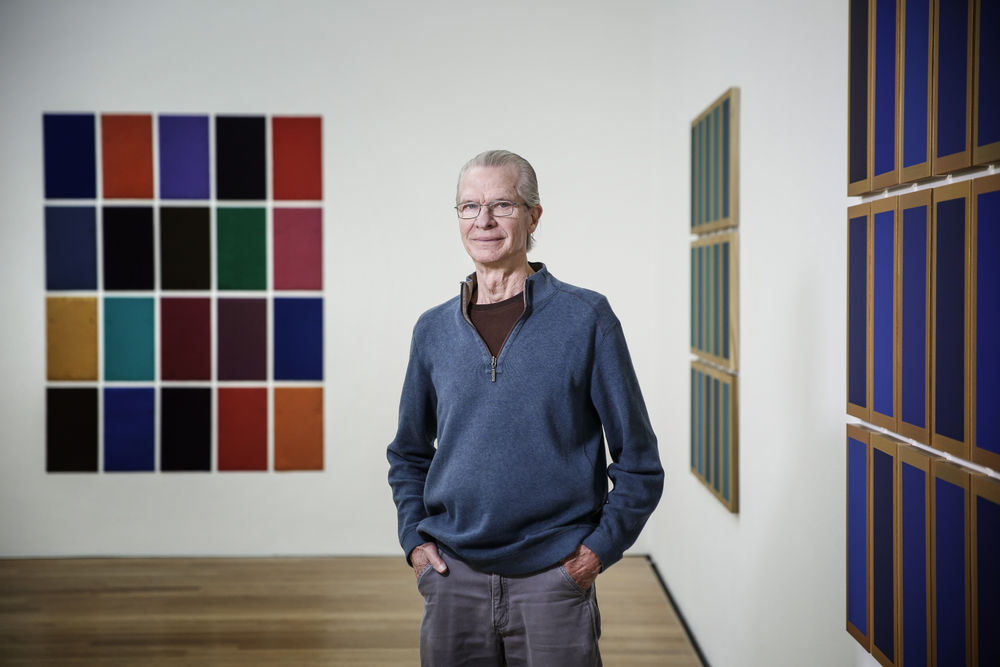Dr. Jörg Daur und Künstler Winston Roeth. Photo: Museum Wiesbaden / Bernd Fickert

that’s how I imagine the Sahara. Of course there are oases. And I know that the desert is full of life, too. But not in this picture. Here we see a surface painted in orange positioned right next to a second surface in white, almost sitting on top of it, each panel wider than its height. The narrow gap between them could be the horizon. I’ve known this picture by Winston Roeth for over ten years. It’s a permanent loan to the museum from the Mondstudio Collection. How many times have I stood in front of it and tried to apprehend that shimmering gap. And every time, as soon as I focus on the centre of the image, the panels seem to extend into the room, encircling me and making me feel like I am staring into the blinding light of the Sahara.
Winston Roeth paints colour, he paints with pure pigments and orchestrates different effects through colour that conjure up the shifting atmospheres of light: the sky, landscapes, day or even night manifest in our mind’s eye creating associations with what we see before us. Quiet Night has been in our collection since 2014. Dark blue tones, violet, black, the sky at night perhaps? One visitor thought she recognized the skyline of Chicago in the picture, at night-time over Lake Michigan. And, yes, Winston Roeth comes from Chicago, and yes, maybe he did infuse the image with his memories of that sky. On slate panels, tiles that he sprinkles with fine pigments. Which he paints delicately with a watery solution (polyurethane dispersion) of pigments. No one panel is the same as another, no colour ever repeated. Some iridescent, shining, others matte.
Several years ago, Roeth began to combine coloured panels in a grid-like pattern. Doing so enabled him to place different colours beside each other, thus establishing a relationship between them. His previous paintings were usually monochrome with narrow borders in a contrasting colour: a frame that contained the pulsating coloured surfaces within. Now, the combination of multiple colours, an infinite number of colours, each one perceptibly different to the next. And yet without any hierarchy. There is no predefined sequence, no specific colour that should or must be looked at first. In this context Roeth speaks of the ‘speed of light’, meaning the speed at which we perceive or perhaps register a colour on a surface, that is, how long, how intensely we look at it.
Our gaze is steered by the golden frames surrounding the colour surfaces – created with fine sponges, the colour of the ground still shines through in places. The eye passes over the border, however, taking in the image, and focussing in on the colour space in the centre. The colour spills out into the surrounding space, becoming a window and a lightbox at once, bathing us in its glow. Depending on where we are standing, it can seem like we are able to see right through the surface, or are being enveloped by it, immersed in the colour, almost sensing it on our skin. In contrast to the slate panels, these surfaces are smooth, the colour space untarnished by the slightest protrusion, its even luminescence undisturbed. The surfaces are essential to the artist – and how the pigment behaves on them. Glossy, shimmery, matte, or something else altogether, changing with our viewpoint and the light falling on the painting.

Painted lines stretch across the surface. They seem monochrome at first, but each line has its own colour, each little box its own content. The grid begins to breathe, introducing a rhythm to the image; yet in essence, it’s nothing more than the projected frame of the image, repeated over and over. The borders are mirrored inwardly, horizontally, vertically. The frame makes the picture.
Winston Roeth crafts his paintings with discerning precision. And has arranged them with the same discernment for the Wiesbaden show. The clarity of his works becomes apparent through the installation. Each work has its own individual character, its universe unfolding as we look on.
Roeth, born 1945 in Chicago, now lives in Beacon (NY) and Waldoboro (Maine) after having spent many years in Manhattan/New York. He enjoys being in nature. He loves light. And even though his paintings are not representational, they show us, in their own way, the beauty of our world. Each work represents the very particular light of a given moment, an hour, a place. Even at night – twenty-four hours a day. Visual manifestations, fluctuating perceptions, grid-like structures that create a sense of space very much their own: an encounter with Winston Roeth’s paintings reveals the potential of our own perceptions and, above all, the power of colour in painting.
Dr. Jörg Daur
Custos of modern and contemporary art
Click here and visit the exhibition-page.
Or maybe watch our video (German): Dr. Jörg Daur and Lea Schäfer give a glimpse in the exhibition!
Translation: Lance Anderson